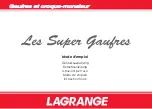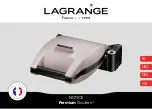
INTRODUCTION
Waking to the smell of homemade bread baking in the kitchen is one of the most comforting memories of childhood
Can you remember rushing downstairs to taste the bread, hot out of the oven, with butter melting on top? What.
a great way to start the morning! The Automatic Breadmaker by PALSONIC can create that same experience every
morning.
There’s very little effort on the part of the baker, because this Automatic Breadmaker is a sophisticated counter-top
appliance with a computer memory that does all the work for you. Just follow the recipe instructions, and wake
up to the old-fashioned smell of fresh bread baking in your Automatic Breadmaker. But don’t stop at baking bread
in this appliance. Besides being able to do all kinds of specialty breads, including 100% whole wheat, you can also
prepare doughs for croissants, bagels, doughnuts, pizzas and more. Everything is easy and tastes homemade,
because it is.
Bake some bread and make some memories, for yourself, and the people you love.
KNOWING YOUR INGREDIENTS
It is often said that cooking is an art relying on the creativity of the chef while baking bread is much more of a science.
This means that the process of combining flour, water and yeast results in a chemical reaction that produces bread.
You have to remember that when the ingredients combine with each other they produce a specific result. Read
the following information carefully to gain a better understanding of the importance each ingredient plays in the
bread making process.
1 ALL PURPOSE FLOUR
All-Purpose Flour is a blend of refined hard and soft wheat flours especially suitable for making breads. Most popular
brands have been tested in the Bread maker with excellent results.
2 BREAD FLOUR
Bread Flour is a high gluten/protein flour that has been treated with conditioners that give dough a greater tolerance
during kneading. Bread Flour typically has a higher gluten concentration than All Purpose Flour; however, depending
on different milling practices this may vary. It is not necessary to use Bread Flour with your Breadmaker, as most
All Purpose Flours will produce loaves with good volume and structure.
3 WHOLE WHEAT FLOUR
Whole Wheat Flour is milled from the entire wheat kernel which contains the bran and germ and makes it heavier
and richer in nutrients than All Purpose Flour. Breads made with this flour are usually smaller and heavier than white
loaves. To overcome this Whole Wheat Flour is usually mixed with All Purpose Flour, Bread Flour, or Gluten Flour
to produce a high light textured bread.
4 RYE FLOUR
Rye Flour is a high fibre flour similar to Whole Wheat Flour, also called Graham Flour. Rye Flour must always be
mixed with a high proportion of All Purpose Flour, Bread Flour, or Gluten Flour, as it does not contain enough gluten
to develop the structure for a high even-grained loaf.
TIPS ON USING YOUR BREADMAKER
13















































